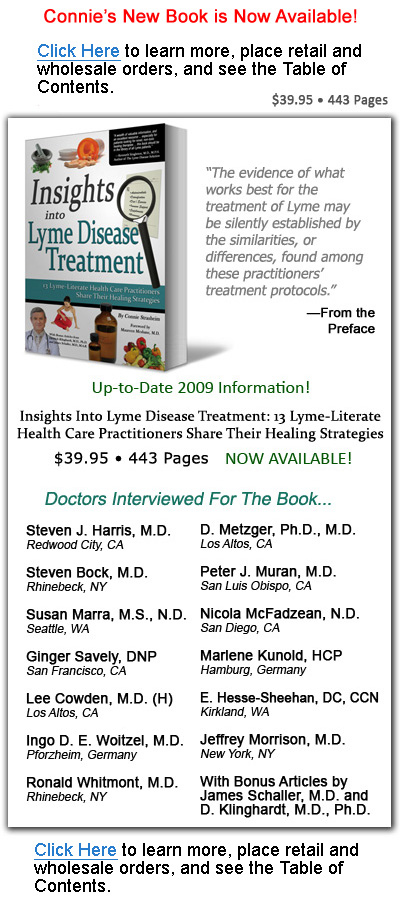Welcome To Lyme Bytes!
April, 2014- HELLO ALL! I am no longer posting to this blog. For the latest on me and my work, I invite you to subscribe to my NEW blog: www.conniestrasheim.blogspot.com where I share my latest findings on how to heal from chronic illness involving Lyme and other conditions. Thanks!
Greetings and welcome to my Lyme disease blog, a comfy cozy (and sometimes crazy!) place for cutting-edge information, encouragement and insight into the fastest-growing epidemic disease in the United States. In this blog you will find everything from bug-killing strategies to immune system and hormone help, as well as lifestyle and spiritual suggestions for healing from chronic illness involving Lyme disease. The information contained within this blog is based upon my own healing journey and what I have learned over the past eight years as I have been diligently digging and researching my way back to a better state of health. May you find it to be a source of hope, inspiration and wisdom in your own journey towards wellness.
About "Insights Into Lyme Disease Treatment"
About the book:
Published August, 2009
Written by Connie Strasheim
Learn More - Bulk Orders - Table of Contents
Sunday, February 10, 2008
Tests And More Tests To Determine Whether A Biochemical Deficiency Is Hindering Your Healing
Shoemaker often prescribes cholestyramine, a cholesterol-lowering drug that also happens to bind toxins, to patients whose detoxification functions are compromised. He has found, however, that administering this drug in those with Lyme disease can actually worsen symptoms, by activating the body's natural inflammatory response. Where this is the case, he prescribes ACTOS, a remedy that counters this process and subsequently reduces symptoms and heals the patient.
But then there are still a group of Lyme sufferers for whom the cholestyramine/ACTOS protocol doesn't work, and Shoemaker contends that these people often have a deficiency of MSH, or melanocyte-stimulating hormone. Bear with me here. I know you might want to stop reading here because you're too tired for big words and biochemisty. Don't worry, it's really not that complicated. MSH is part of the body's master immune response, determining cytokine, (or inflammatory marker) response, as well as other processes. Shoemaker discovered that people who are deficient in MHS tend to have a greater number of pathogens in their mucus membranes--the nose, lungs, gastrointestinal tract, and so forth, which ultimately compromises the healing process. Also, MHS controls melatonin production and endorphin release, so low levels contribute to insomnia, depression and other symptoms. If MHS levels can be raised, then biochemical processes become more efficient and patients recover.
Yet Shoemaker has found that for some, addressing MHS levels and administering cholestyramine isn't enough, because still other factors can compromise recovery. Such as when auto-immune processes are at work, and the body produces antibodies against myelin, for example, or cardiolipids, which are linked to lupus and rheumatoid arthritis. By testing a person's TGF levels, or, Transforming Growth Factor, clues to auto-immunity can be discerned.
I must say, this guy is really a detective. When one stone hasn't uncovered the truth, he goes for another in his abundant rock garden of solutions.
If patients still don't improve after auto-immunity factors have been dealt with, then Shoemaker tests for VEGF, or vascular endothelial growth factor. Never mind what it means. I can't tell you. Just remember the acronym and know that low levels of the stuff prevent the body from normal delivery of oxygen to cells. By testing for it, Shoemaker determines whether an oxygen deficiency is contributing to a patient's symptoms.
Fortunately, of the above can be measured with routine lab tests. What? You say. Yes, surprise, surprise. Your doctor can order them and discern whether any of the above are keeping those antibiotics or other treatments from working. Because, according to Shoemaker, if these factors are present, then it doesn't matter how many antibiotics you take--you won't heal unless you deal with the deficiencies.
Finally, Shoemaker believes that up to twenty percent of those with Lyme disease have gene haplotypes (referring to a set of linked genes or DNA polymorphisms) which indicate an impaired ability to detoxify biotoxins. Testing for these haplotypes can also be done at your local lab. Numbers to look for in the results are as follows: 15-6-51, 16-5-51, 1-3-53, and 11-5-52b. If you have one of these patterns, then it means you'll have trouble getting rid of toxins without supportive therapies.
In determining whether protocol are successful, Shoemaker uses the visual contrast sensitivy test to help discover whether biotoxins are being removed and spiros killed. Additionally, he performs C3-A and C4-A lab tests, (additional markers of immune and detox activity). If C4-A levels are above the normal range after treatment for Lyme, then other toxic exposures (such as mold) should be suspected. Likewise, if C4-A levels fall after treating for Lyme, but symptoms remain, then co-infections are probably present.
In summary, Shoemaker has unearthed biochemical deficiencies that prevent some from healing from Lyme disease. Fortunately, and while I am unaware of his protocol for treating all of these, solutions exist to give the body a helping hand wherever pieces are missing in the biochemical puzzle.



No comments:
Post a Comment